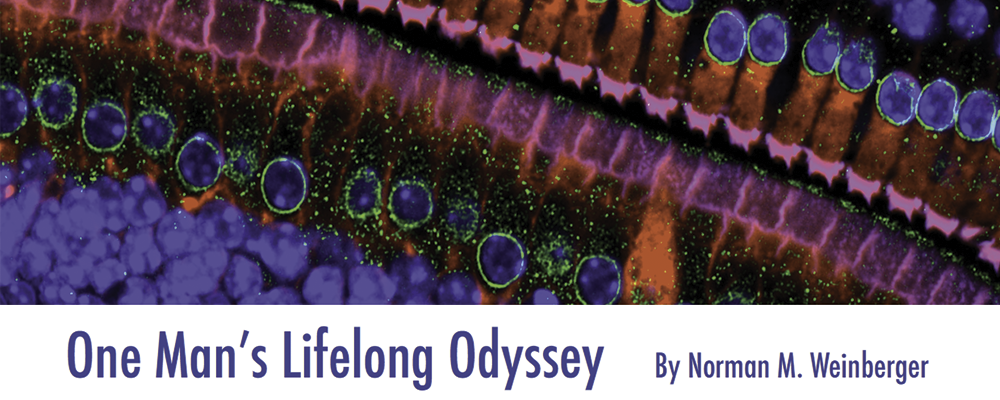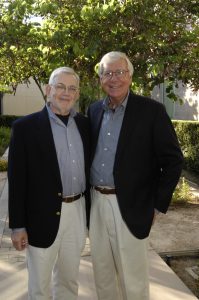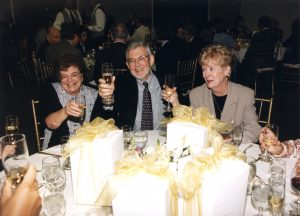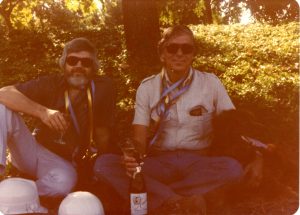One Man’s Lifelong Odyssey: By Norman Weinberger

Professor Weinberger wrote the following article in celebration of the 50th anniversary of the University of California, Irvine’s Psychobiology department (now the Department of Neurobiology and Behavior). Download the PDF here.

Prof. Norman Weinberger (left) pictured with lifelong friend Prof. James McGaugh.
“The University of California will be opening new Campuses and I’ll get a job at one of them.” This, in response to my wife Jacquie’s simple question of what would happen next if we moved (ourselves and our three young children) to California. It was 1960 and I was in the last year of study for a doctorate in experimental psychology at Western Reserve University in Cleveland, Ohio, our hometowns. I had been unsatisfied with the study of behavior purely at the behavioral level and believed that UCLA or UCSF were the best places to undertake postdoctoral study in the rapidly developing field of brain sciences. Indeed, UCLA was then starting to build the Brain Research Institute (BRI). My answer, intended to be reassuring, had only two problems. First, I did not know if I could obtain a post-doctoral position in California. Second, I had absolutely no knowledge that any new UC Campuses would be built. Furthermore, there was no reason to believe that, even if both came to pass, I would secure a highly coveted faculty position. There are at least two judgments of my answer: it was highly duplicitous or it was overly optimistic! But at its foundation, Jacquie and I have trusted and supported each other for more than sixty years, through all the vagaries of life, including being fortunate enough to have seven wonderful people as our children: Amy, Linda, Eric, Tami, Jenny, Lisa and Andrea.
Donald B. Lindsley, of UCLA’s Departments of Psychology and Physiology, was the most distinguished “physiological psychologist” of the mid-20th Century. He had been elected to the National Academy of Sciences for paradigm-shifting research. He co-discovered the reticular activating system, which is the foundation for our contemporary understanding of the regulation of the cerebral cortex and behavioral state, and the basis for the modern field of neuromodulation. Dr. Lindsley accepted my postdoctoral application and provided both inspiration and practical support during my three and a half years in his laboratory, June, 1961 – December, 1964. The BRI was an exciting and stimulating place, and I had the opportunity to meet most of the world’s major brain scientists as they visited.
Dr. Lindsley asked me to investigate the medial thalamic component of the reticular system as its stimulation could also produce widespread cortical activation. This required that I learn something of neuroanatomy, neurophysiology, neurohistology, electronics, plus electrode construction and animal surgery. Largely self-taught, I stumbled my way into neuroscience, linking the “thalamic reticular system” (TRS) to behavioral arousal and also to associative learning. This largely unsupervised work resulted in seven papers; the bottom line was that direct TRS projections to the cortex were not activating but rather the opposite, i.e., they promoted slow wave and other sleep-like brain rhythms. Its ability to activate both the EEG and behavior appeared to depend upon its descending projections to the basal forebrain area, which was later found to drive the cholinergic nucleus basalis to activate the cortex.
UC’s plans to shortly open three new Campuses caught my attention in 1963. Oddly, this information came by happenstance rather than by announcement. Two of Jim McGaugh’s undergraduate students at the University of Oregon, Les Fehmi and Joel Adkins, happened to be graduate students in Lindsley’s lab, and they seemed well-informed. In early 1964, Dr. Lindsley arranged for Jim, as the newly appointed chair of Psychobiology at UCI, to meet with me during a visit to UCLA. I later interviewed with him in Portland, Oregon at the Western Psychological Association meeting. Jim’s hotel room was littered with both behavioral and electrophysiological equipment catalogs as he had to set up planned undergraduate and graduate teaching laboratories. My experience in having built both behavioral and electrophysiological set-ups was a positive. In the Spring of 1964, Jim interviewed me again, this time overlooking the UCI building site from the corner of MacArthur and Bison. A grand view from the silo-barn complex of William Pereira, master architect for the project, revealed only several large holes in the ground. But since Jim and I shared the same vision of a new type of brain-behavior department, the lack of brick and mortar was no obstacle. His call came in April and there was never the slightest doubt about joining him in this quest which is now fifty years of age.
Arriving at UCI January1st 1965, our labs were housed in “temporary” buildings on the North Campus. Planning for the Department was intensive and we were joined by Dick Whalen, who studied hormones and animal behavior whom. At the time, I certainly did not realize that Psychobiology (the brainchild in both concept and name of our founding dean Edward Steinhaus) was itself an “experiment”. We were allocated only our three faculty slots, the fewest number that could constitute an independent department at UC. If we failed, there would be less “debris” to clear. In fact, within two years, Psychobiology received more applications for our graduate program than the rest of UCI combined.
We established the Department on the basis of several principles. First, Psychobiology would be an integrated department, covering brain and behavior across levels, from the molecular/chemical through cells, circuits, systems and behavior. Second, new faculty would be able to appreciate the research of existing faculty, and vice-versa. This was intended to promote both formal and informal collaborations, prevent fragmentation and foster commitment to the common good. Third, graduate students would be admitted by the Department, not by individual faculty, and would be able to move among labs as the situation dictated. Fourth, there would be one class of graduate students, not separate research and teaching assistants; all students would teach and all would do research of high quality. (We had all come from standard graduate programs in which those supported by teaching funds received less pay and a heavier work load than students receiving stipends from research grants.) We established this principle not only to be fair, but also to encourage cooperative interactions among students from various labs.
We admitted our inaugural class of six graduate students in September 1965. Within a few years, they added another principle. Insofar as they were required to teach the undergraduate labs, they requested, and quickly received, permission to also have responsibility. They wrote the lab manuals, devised the demonstrations and as we grew, organized themselves into committees each of which devised and proofed the lab exercises.
 Psychobiology continued to grow over the first ten years. Our faculty recruiting focused on realizing the plan to cover all levels of research and, by and large, this goal was realized. Personally, because there were not enough faculty to accomplish the myriad jobs tasks necessary to operate a research university, I immediately became heavily involved in administrative matters. At one time, I believe that I was either chair or a member of a dozen Campus-wide committees, ranging from the operation of the libraries through undergraduate admissions, health sciences planning, the committee on academic freedom and delegate to the University-wide Committee on Educational Policy. I learned how things should work, why they often did not work and how to use interpretive creativity to get them to work. For this insane amount of activity, I received the UCI Outstanding Service Award in 1975. I have served with pleasure as Chair of the Department, and also in several key posts of the School of Biological Sciences, including Dean, and found that I much preferred other duties.
Psychobiology continued to grow over the first ten years. Our faculty recruiting focused on realizing the plan to cover all levels of research and, by and large, this goal was realized. Personally, because there were not enough faculty to accomplish the myriad jobs tasks necessary to operate a research university, I immediately became heavily involved in administrative matters. At one time, I believe that I was either chair or a member of a dozen Campus-wide committees, ranging from the operation of the libraries through undergraduate admissions, health sciences planning, the committee on academic freedom and delegate to the University-wide Committee on Educational Policy. I learned how things should work, why they often did not work and how to use interpretive creativity to get them to work. For this insane amount of activity, I received the UCI Outstanding Service Award in 1975. I have served with pleasure as Chair of the Department, and also in several key posts of the School of Biological Sciences, including Dean, and found that I much preferred other duties.
In research, my initial goal was to find out how a behaviorally neutral sensory stimulus gained associative power and ultimately produced adaptive behavior. I chose to use the auditory system because there was a wealth of basic anatomical and physiological knowledge and it was relatively easy to precisely control sound parameters. Unexpectedly, the study of neurobehavioral processes in auditory associative learning led to a paradigm shift in conceptions of the general functional organization of the cerebral cortex.
The standard model for more than 100 years has been that sensory stimuli are processed within a modality up to the primary (now often called “early”) sensory cortex: auditory (A1), somatosensory (S1)and visual (V1). After analysis and identification, this information was passed on to “higher” sensory cortex where its behavioral meaning or relevance was determined. Thereafter, other “higher” cortical areas conducted further processing until behavior was initiated in the motor systems. This concept is so deeply ingrained in neuroscience that it is virtually impossible to find an explicit discussion of it anywhere. In effect, this doctrine assigned primary sensory fields as the only parts of the cerebral cortex that did not directly participate in learning and memory; thus, they should not develop plasticity during the acquisition and storage of information. However, as early as the mid-1950s, increases in auditory evoked potentials to acoustic conditioned stimuli had been reported in A1. We decided to determine whether or not associative plasticity truly did develop in primary auditory cortex. A list of the necessary controls ex from undetected contractions of the middle ear muscles through assessment of the thalamic auditory system would take too much space, but this line of research did occupy our lab for almost a dozen years. We found that associative plasticity was genuine.
However, our reports had little impact on the field as a whole. We realized that sensory neuroscientists would not take note until we demonstrated that learning, systematically altered the parameters they studied, i.e., sensory receptive fields. Therefore, in the mid-1980s, we first determined the effects of classical conditioning on receptive field frequency tuning in the auditory system. The results were beyond our expectations. Associative processes could rapidly and specifically shift tuning to the frequency of any tone conditioned stimulus that signaled reinforcement. By 1990, we had firmly established a new form of plasticity in A1, termed “representation plasticity” (RP). Whereas “plasticity” is very widely applied to almost any instance of non-transient neural change, representational plasticity consists of systematic modification of a parameter of sound, e.g., acoustic frequency. The implications of representational plasticity transcend local plasticity because RP alters the processing of future sounds within the modified acoustic dimension.

Professor Weinberger with Mrs. Jacquie Weinberger (left) and Mrs. Audrey Schneiderman (right).
During the past 25 years, research has been extended internationally and RP has been found to be ubiquitous, developing across species (including humans), in all tested sensory systems for all relevant stimulus parameters, during a wide variety of tasks and types of motivation. Sufficiently numerous individual tuning shifts produce specific gains in representational area within primary cortical “maps”, the amount of which is directly proportional to both the cue’s level of acquired importance and its memory strength. In parallel studies of the cholinergic nucleus basalis we found a likely candidate mechanism for the formation of specific memory in the primary auditory cortex. The engagement of mAChRs in A1 by pairing a tone with stimulation of the nucleus basalis induces specific tuning shifts identical to those that develop during natural learning and, most importantly, also produces specific behavioral memory that has the same features as natural associative memory. Furthermore, even when animals mis-remember the exact frequency of a paired tone, there is a precise match between their memory and the frequency of the expanded A1 representation. Together with prior findings for detection, correlation and mimicry of plasticity with the acquisition of memory, these findings satisfy a key criterion for a neural substrate of memory in primary auditory cortex. Thus, the assumed strict cortical separation between sensory analysis and learning about the world in which we live is wrong. As the neural substrates of learning and memory form at the first stage of cortical sensory processing, a new functional model is required, one that is far more integrative than the dogma of the last 100 years.
Along the way, I have dabbled in topics less fundable but of personal interest, primarily music and the brain. I believe that our research is relevant to learning in general, particularly to auditory learning, which is a major component of music. We published some papers showing that neurons in A1 could encode sequences of notes, not simply respond to individual tones. I served as Executive Director of the International Foundation for Music Research for three years and found both enjoyment and public service in writing articles for the general public on the importance of music education and explaining contemporary findings in music science (www.musica.uci.edu).

Prof. Weinberger and Prof. McGaugh celebrating the groundbreaking of the Bonney Research Laboratory Building
One of the main professional joys of my life has been the founding and subsequent contributions of the Center for the Neurobiology of Learning and Memory in 1982. In addition to the stimulating regular discussions among the members, we organized and hosted several major international conferences over a period of several years. These each had a focus on a particular problem in learning and memory and brought together premier neuroscientists internationally. Both the meetings themselves and the monographs they produced were highly influential in promoting the field.
I have been extremely fortunate to have the lab funded continuously from 1966 to 2019. Whatever it has accomplished reflects the efforts and dedication of the many outstanding undergraduates, graduate students, postdocs and research associates who transformed our laboratory spaces into vibrant and scintillating workshops of the mind and of the brain. They certainly deserve whatever credit is due but I will not attempt to list them here. I do want to give special acknowledgment to Jim McGaugh who has and continues to be close friend and colleague and a constant source of strength.
In closing, I want to dedicate this account to two men whose untimely passing remains a crushing blow to friends and family. Howard Schneiderman, the third dean of the School, provided wisdom, humor, enthusiasm and support, plus convincing us to visit Yellowstone and Grand Teton National Park, where my family summered for more than 30 years. John Ashe received his doctorate in my laboratory and after post-doctoral work in synaptic physiology later became Chair of Psychology at UC Riverside. A man of the highest integrity and clear vision, I undoubtedly learned more from him than he from me. Certainly, he tutored me on the cholinergic system after his appointment at UCR, and we enjoyed a fruitful collaboration for several years. No finer man have I ever encountered.
###
Learn more about Professor Weinberger and the Weinberger Memorial Graduate Student Award by clicking here.
